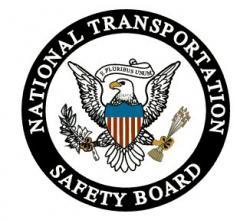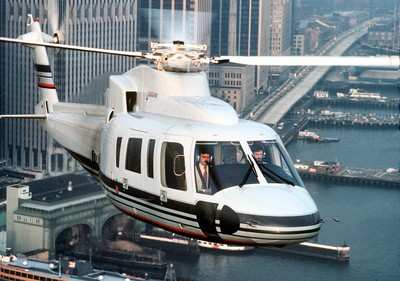 Last weeks's downing of
a PHI Sikorsky S-76A++ (file photo, below), which put two pilots in
the drink and resulted in the loss of the aircraft, now appears to
have a number of weather related factors to consider in the NTSB's
ongoing investigation. The Gulf is a tough place for helos.... even
for professional crews.
Last weeks's downing of
a PHI Sikorsky S-76A++ (file photo, below), which put two pilots in
the drink and resulted in the loss of the aircraft, now appears to
have a number of weather related factors to consider in the NTSB's
ongoing investigation. The Gulf is a tough place for helos.... even
for professional crews.
NTSB Identification: DFW07LA011
14 CFR Part 91: General Aviation
Accident occurred Sunday, October 22, 2006 in Eugene Island,
GM
Aircraft: Sikorsky S-76A++, registration: N22342
Injuries: 1 Minor, 1 Uninjured.
This is preliminary information, subject to change, and may
contain errors. Any errors in this report will be corrected when
the final report has been completed.
On October 22, 2006, approximately 0730 central daylight time, a
Sikorsky S-76A++ twin-engine helicopter, N22342, registered to and
operated by Petroleum Helicopters, Inc. (PHI), of Lafayette,
Louisiana, was destroyed when it impacted the water while landing
near offshore platform Eugene Island (EI) Block 259, located in the
Gulf of Mexico. The airline transport rated pilot was not injured,
but the commercial rated first officer sustained minor injuries.
There were no passengers aboard the helicopter at the time of the
mishap. Visual meteorological conditions prevailed, and a company
flight plan was filed for the 14 Code of Federal Regulation Part 91
on-demand air taxi flight. The local flight departed PHI's base in
Amelia, Louisiana, at 0658, and was destined for EI 259 to pickup a
passenger.

A representative of the operator stated in the Pilot/Operator
Aircraft Accident Report (NTSB Form 6120.1) that after takeoff from
PHI's base at Amelia, the pilot-in-command (PIC) encountered a
cloud deck at 500 feet and leveled the helicopter at approximately
at 450 feet, with the visibility at approximately 10 miles. A call
was received by the crew that EI 259 had encountered moderate rain,
poor visibility and a low ceiling. The PIC responded that he was
aware of the weather line of rain showers, and expected them to
move through the area prior to their arrival. The crew called EI
259 about 20 minutes out giving their estimate time of arrival, and
were told that it was still raining.
 At 2 nautical miles
(NM) from EI 259, the crew could not see the platform due to the
rain, so the PIC turned the helicopter to the West to circle the
rain shower and called for the pre-landing check. At just under 2
NM west of the platform, the first officer saw the platform, and
the PIC called for the floats to be armed and the windshield wipers
to be turned on. At this time the, wind was from 340 degrees. As
the PIC turned to final, he remembers his altimeter indicating 250
feet and airspeed 55-60 knots, and seeing the platform, but not
seeing a visible horizon. The PIC estimated moderate rain, while
noticing that the floats were not armed and that the rain on the
wind shield was obscuring his vision. He asked the first officer
again to arm the floats and turn on the wipers. The first officer
appeared to be fumbling with the switches as the PIC looked down to
see what was happening. At that time, the helicopter made contact
with the water, rolled over, and began filling with water. The
first officer escaped by jettisoning his entry door and the PIC
escaped through the a missing windshield.
At 2 nautical miles
(NM) from EI 259, the crew could not see the platform due to the
rain, so the PIC turned the helicopter to the West to circle the
rain shower and called for the pre-landing check. At just under 2
NM west of the platform, the first officer saw the platform, and
the PIC called for the floats to be armed and the windshield wipers
to be turned on. At this time the, wind was from 340 degrees. As
the PIC turned to final, he remembers his altimeter indicating 250
feet and airspeed 55-60 knots, and seeing the platform, but not
seeing a visible horizon. The PIC estimated moderate rain, while
noticing that the floats were not armed and that the rain on the
wind shield was obscuring his vision. He asked the first officer
again to arm the floats and turn on the wipers. The first officer
appeared to be fumbling with the switches as the PIC looked down to
see what was happening. At that time, the helicopter made contact
with the water, rolled over, and began filling with water. The
first officer escaped by jettisoning his entry door and the PIC
escaped through the a missing windshield.
 ANN's Daily Aero-Linx (04.30.25)
ANN's Daily Aero-Linx (04.30.25) ANN FAQ: Turn On Post Notifications
ANN FAQ: Turn On Post Notifications Classic Aero-TV: Agile Aeros Jeff Greason--Disruptive Aerospace Innovations
Classic Aero-TV: Agile Aeros Jeff Greason--Disruptive Aerospace Innovations Aero-News: Quote of the Day (04.30.25)
Aero-News: Quote of the Day (04.30.25) ANN's Daily Aero-Term (04.30.25): Expedite
ANN's Daily Aero-Term (04.30.25): Expedite





